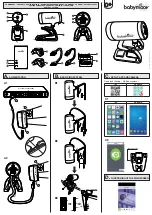
English-26
Troubleshooting
No picture
• The signal cable should be completely connected to the display card/computer.
• The display card should be completely seated in its slot.
•
The monitor does not support DisplayPort converter adapter.
•
When you use DisplayPort signal, check to make sure not to plug the input signal cable in DisplayPort out connector.
• Power Switch and computer power switch should be in the ON position.
• The monitor will automatically turn off by “POWER SAVE TIMER” function when “
POWER SAVE TIMER” setting is “ON”
and continuing power save mode for 2 hours. Please press the power key.
• Check to make sure that a supported mode has been selected on the display card or system being used.
(Please consult display card or system manual to change graphics mode.)
• Check the monitor and your display card with respect to compatibility and recommended settings.
• Check the signal cable connector for bent or pushed-in pins.
• Check the signal input.
• If the front LED is dark blue, check the status of the OFF MODE SETTING mode (see page 16) or Human sensor*
(see page 17).
• When using an HDMI input, please change “OVER SCAN”.
Power Key does not respond
• Unplug the power cord of the monitor from the AC outlet to turn off and reset the monitor.
• When something is stuck on the bezel, key becomes unresponsive.
Keys do not respond
•
Check INDIVIDUAL ADJUST setting. If it is ON, please press CENTER/EXIT and INPUT/SELECT keys simultaneously.
Image Persistence
• Image persistence is when a residual or “ghost” image of a previous image remains visible on the screen. Unlike CRT
monitors, LCD monitors’ image persistence is not permanent, but constant images being displayed for a long period
of time should be avoided. To alleviate image persistence, turn off the monitor for as long as the previous image was
displayed. For example, if an image was on the monitor for one hour and a residual image remains, the monitor should
be turned off for one hour to erase the image.
NOTE:
As with all personal display devices, NEC DISPLAY SOLUTIONS recommends using a moving screen saver at
regular intervals whenever the screen is idle or turning off the monitor when not in use.
Message “OUT OF RANGE” is displayed (screen is either blank or shows rough images only)
• Image is displayed only roughly (pixels are missing) and OSD warning “OUT OF RANGE” is displayed: Either signal
clock or resolution is too high. Choose one of the supported modes.
• OSD warning “OUT OF RANGE” is displayed on a blank screen: Signal frequency is out of range. Choose one of the
supported modes.
Image is unstable, unfocused or swimming is apparent
• Signal cable should be completely attached to the computer.
• Use the OSD Image Adjust controls to focus and adjust display by increasing or decreasing the fine adjustment.
When the display mode is changed, the OSD Image Adjust settings may need to be readjusted.
• Check the monitor and your display card with respect to compatibility and recommended signal timings.
• If your text is garbled, change the video mode to non-interlace and use 60Hz refresh rate.
LED on monitor is not lit (
no blue or amber color can be seen
)
• Power Switch should be in the ON position and power cord should be connected.
• Increase LED BRIGHTNESS adjustment.
Picture is not as bright
• Make sure ECO MODE and AUTO BRIGHTNESS* are turned off.
• If the brightness fluctuates, make sure AUTO BRIGHTNESS* is turned off.
• Signal cable should be completely attached.
• LCD brightness degradation occurs due to long-term usage or extreme cold conditions.
• When using an HDMI input, please change “VIDEO LEVEL”.
•
If the brightness fluctuates, make sure DV MODE is set to STANDARD.
*: This function is available when option unit sensor is used.








































